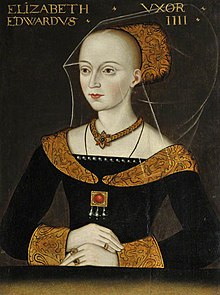Elizabeth Woodville
Queen Elizabeth Woodville | |
|---|---|
 | |
| Born | 3 February 1437[1] Grafton Regis, England |
| Died | 8 June 1492 (aged 55) Bermondsey, England |
Elizabeth Woodville (Also known by Elizabeth Wydeville) was the wife of King Edward IV of England. She was the mother of King Edward V of England. She was also the mother of Elizabeth of York, the queen consort of King Henry VII of England.[2]
Elizabeth was born some time around the year 1437, at Grafton Regis, Northamptonshire. Her parents were Sir Richard Woodville and his wife, Jacquetta of Luxembourg, a foreign noblewoman who had first been married to the Duke of Bedford. After her first husband died, Jacquetta fell in love with Sir Richard, who was not very rich or important even though he was a knight. Jacquetta's friends and family felt that it was an unsuitable marriage and that he was not good enough for her. They had fourteen children altogether.
When Elizabeth first met Edward, she was a widow. Elizabeth and her first husband, Lord Grey, had two sons, Thomas and Richard. Then Lord Grey was killed in battle, fighting on the opposite side to King Edward. Because she was a widow who already had children, and because her family had supported King Edward's enemies, she was thought to be an unsuitable wife for the king. Elizabeth and Edward were married in secret, because the king did not want to quarrel with his great friend the Earl of Warwick, who wanted Edward to marry a princess. At the time of their marriage, Edward was 22 and Elizabeth a few years older.
When the Earl of Warwick discovered that the young king had married Elizabeth without his permission, he was furious. Although he was forced to accept the marriage, he became angry at the way Elizabeth's family grew powerful as a result of her becoming queen. A few years later, he turned against Edward and tried to put his rival, King Henry VI of England, back on the throne. While Edward was fighting to get his throne back, Elizabeth went to Westminster Abbey to find sanctuary; this meant that, because the abbey was a holy place, she could not be captured by her enemies as long as she remained there. While there, she gave birth to her first son, who was named Edward after his father. After a while, her husband returned and rescued her and her children, defeating the Earl of Warwick in battle and killing him.
Elizabeth and Edward had ten children altogether. Their eldest son, Edward, should have become king when his father died. However, King Edward died suddenly, and his own younger brother, Richard, Duke of Gloucester, snatched the throne. Richard hated the Woodville family, and killed Elizabeth's brother Anthony, who had been the guardian of her son Edward. Both Edward and Elizabeth's younger son, Richard, were placed in the Tower of London (which was then a royal palace). After a few months, they disappeared, and it was thought that King Richard had killed them. This rumour made the new king unpopular with many of his people, and two years later, Henry Tudor took the throne from him in battle and became King Henry VII of England. Henry VII married Elizabeth's eldest daughter, who was also called Elizabeth. Elizabeth Woodville herself died a few years later at Bermondsey Abbey.
Further reading[change | change source]
- Licence, Amy (2016-02-15). Edward IV & Elizabeth Woodville: A True Romance. Amberley Publishing Limited. ISBN 978-1-4456-3694-8.
- Hodder, Sarah J. (2020-03-27). The Queen's Sisters: The Lives of the Sisters of Elizabeth Woodville. John Hunt Publishing. ISBN 978-1-78904-364-8.
- Baldwin, David (2011-08-26). Elizabeth Woodville: Mother of the Princes in the Tower. The History Press. ISBN 978-0-7524-6897-6.
- MacGibbon, David (2013-04-15). Elizabeth Woodville - A Life: The Real Story of the 'White Queen'. Amberley Publishing Limited. ISBN 978-1-4456-1298-0.
References[change | change source]
- ↑ "Elizabeth Woodville (1437-1492) - Find a Grave". Find a Grave.
- ↑ David Baldwin, Elizabeth Woodville: Mother of the Princes in the Tower. Stroud, 2002.
